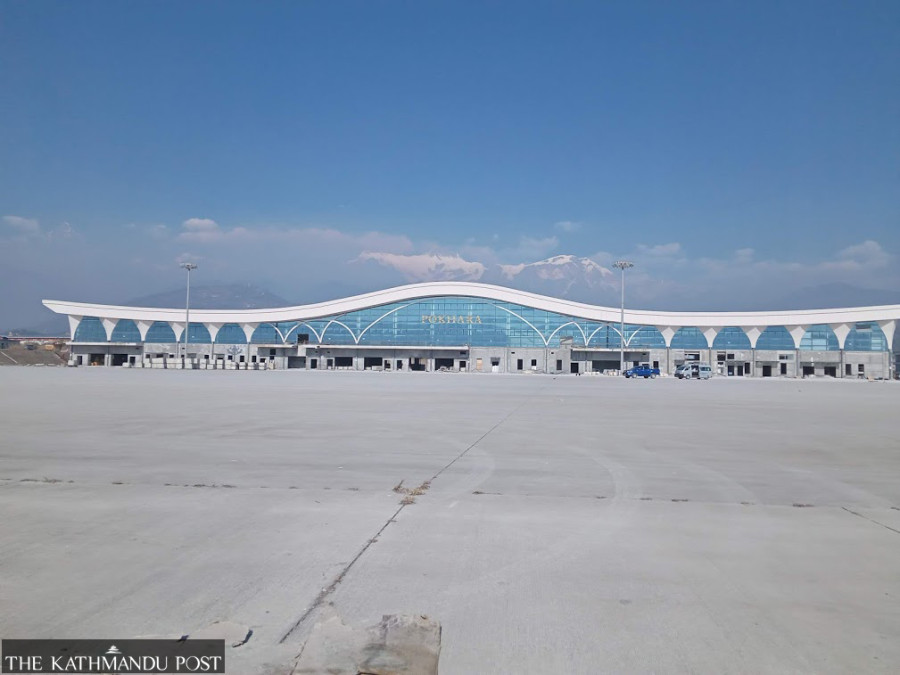Money
Covid-19 pushes back completion of Pokhara international airport
The airport in the tourist city may take another year or longer to be ready, officials say.
Sangam Prasain
The Covid-19 pandemic has pushed back the completion of the under-construction international airport in Pokhara by at least a year, as work had to be stopped and the workers sent home due to virus fears, officials said.
The $215.96 million Chinese-funded project had been racing ahead of schedule, and was in line to open six months before the planned date of July 10, 2021. But the coronavirus threw a spanner in the works; and the project completion deadline, which falls on Saturday, will be a non-event.
“Work continued during the lockdown last year and this year too, but progress slowed to a crawl as the project was shorthanded,” said Rajan Pokhrel, director general of the Civil Aviation Authority of Nepal, the project execution body. “The contractor has requested us for a year's extension of the deadline.”
He said that a meeting would soon decide about lengthening the time limit.
Prime Minister KP Sharma Oli had laid the foundation stone of the project, which will serve as the gateway to the Annapurna region, celebrated as the world's most popular trekking trail, in April 2016.
“Looking at the current situation with the Covid-19 uncertainty still prevailing, the completion of the project may take another year or longer than that,” said Pokhrel.
Pradip Adhikari, who heads the national pride project at the Civil Aviation Authority of Nepal, told the Post that the scheme had achieved 78 percent physical progress.
According to him, if there are no more lockdowns, all tasks—including installation and testing of the navigation and meteorological equipment, and certification of the airport—may be completed by April 2022.
He said that 200 workers were still engaged at the construction site.
After the coronavirus pandemic struck, only one-third of the daily tasks could be done, project officials said.
The selection of the construction site, detailed engineering work and master plan of Pokhara International Airport was initially prepared in 1971 by DIWI, a German consulting engineering firm.
This work was performed by the erstwhile Department of Civil Aviation with an Asian Development Bank loan under the Airport Development Project in Nepal.
The government had acquired 3,106 ropanis of land to build the facility in 1975.
In 1988, the Japan International Cooperation Agency (JICA) conducted a review of the new Pokhara Airport Master Plan prepared by DIWI.
JICA proposed to implement the project in two phases—the first from 1995-2000 at an estimated cost of $40 million.
The second phase from 2001-10 was estimated to cost $45 million, following the completion of which the airport would be able to handle aircraft like the Boeing 757.
China CAMC Engineering won the construction contract for the project in May 2014, and work started in July 2017.
The government signed a $215.96 million soft loan agreement with China EXIM Bank in March 2016 to finance the construction of the airport which was implemented under an engineering procurement and construction model.
Under this model, a single contractor is responsible for all components like design, engineering, construction and procurement.
The runway of Pokhara International Airport is 45 metres wide and 2,500 metres long, and has an east-west orientation. The runway will be able to handle medium-range commercial aircraft such as the Airbus A320, Boeing 737 and Boeing 757.
The airport will have a 1,200-metre-long and 23-metre-wide taxiway connecting the runway with the parking bays, hangars and terminals.
The main international terminal building has a capacity to handle 650 passengers per hour. The airport will have three parking bays for A320-type jets with aerobridge facility, and five parking bays for ATR-type aircraft.
There will be a separate terminal and parking bay for domestic flights.




 9.12°C Kathmandu
9.12°C Kathmandu















